Last Updated on January 17, 2024 by Greg Gillson
Feeding birds in winter is enjoyed by many people.
Perhaps you feel that feeding wild birds is only an activity for snow-covered northern areas. But this is not true. Even in sunny Florida feeding birds is a common activity.
Would you like to set up a backyard bird feeder this winter in Florida? This article is for you!
This article tells all about why and how to set up a winter bird feeding station in Florida. I will discuss just a few of the very many birds you could attract to your feeders, and how to do it.
The weather in Florida in winter is quite mild. It is similar to coastal southern California.
Depending on whether you live north or south, the average night time temperatures range from 41-65 degrees Fahrenheit. Daytime highs in winter average between 64-77 degrees F.
A few flakes of snow may fall twice a decade in northern Florida. But snow sticking on the ground is a very newsworthy event, and doesn’t last long.
Nevertheless, feeding birds in winter is still worth while. I’ll tell you why.
Why feed winter birds in Florida?
Florida has many resident birds that spend the entire year in your backyard and neighborhood. Many can be enticed to come to your feeders.
Florida also enjoys many winter bird visitors. These migrate south to Florida to escape the cold, snowy winters to the north. These all appreciate a steady source of winter food–even if they could probably survive just fine on their own without bird feeders.
But birds need more than just food. They need protective shelter. Many people who care about birds set up bird feeders. But they also landscape their yards to make them a safe haven for the birds that visit. Natural wildlife habitat is constantly being lost to urban sprawl, deforestation, and changes in the way people use land. So even if a few birds benefit from your backyard landscaping, it makes a difference.
Young birds in their first winter are less experienced than the adults. They may have trouble some times locating enough food. So your backyard feeder might help more of these birds survive the winter.
But you may benefit more than the birds you feed! Watching birds gives you peace of mind as they flit here and there. Observing nature, even in your backyard, is good for your mental health.
It also makes you more aware of the natural world. This awareness will lead you to make decisions in life that take into account the consequences of your actions on other living things and systems.
It might not seem like one person can change all the ills in the world. And that is true. But you are not one person. You are one more person that cares. And one less person that doesn’t.
If you can share feeding birds in winter with children, you can have a positive impact on their lives. Children spend less time outside playing and viewing nature than ever in our history. Many people warn that this has a negative effect on children, and on society.
Connect with nature. If that means feeding birds, please do so. It’s fun!
What birds come to feeders in Florida in winter?
Lots of northern birds winter in Florida. The mild weather allows many insect-eating birds to spend the winter. But Florida has many birds that also eat seeds or fruit you can offer at your feeder.
Some backyard birds don’t come to feeders. Some birds visit your backyard during different times of year. To learn about some of those, please read my article on common backyard birds of Florida. I’ll link to it again at the end of this article.
Here, then, are some of the common and popular winter birds at feeders in Florida.
Northern Cardinal
These large colorful songbirds are found throughout woodlands in the eastern United States and adjacent extreme southern Canada.
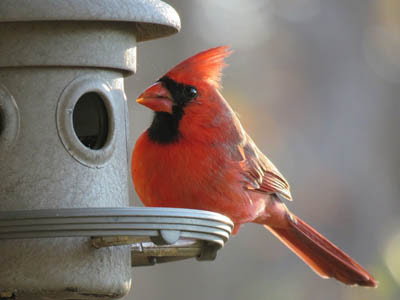 |
| Northern Cardinal Image by GeorgeB2 from Pixabay |
They are found throughout Florida. These birds are residents, pairs staying year-round in the same location for the most part.
They sing nearly year-round with loud whistled phrases usually repeating 3 times, cheer cheer cheer or purty purty purty. They also have a loud chip note.
Males are bright red with large tail, sweeping crest, thick orange bill and black face. Females are shaped similarly, but buffier brown overall.
Northern Cardinals eat larger seeds, including sunflower seeds and safflower seeds from hopper and platform feeders.
Mourning Dove
 |
| Mourning Dove Photo by Greg Gillson |
These birds are widespread across North America, including all of Florida. They are found in rural areas, especially near agricultural areas, and in residential areas, too.
The call is a loud mournful cooing.
These bird are identified by the plump body, small round head, and long pointed tail. The coloration is tan-brown, a bit pinkish on the breast. There are several large black dots on the wing coverts.
Mourning Doves eat black oil sunflower seeds and cracked corn and other grains. They feed on the ground and prefer platform feeders.
Blue Jay
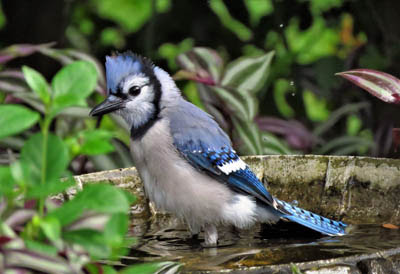 |
| Blue Jay Image bly skeeze from Pixabay |
Found in deciduous woodlands across eastern and central North America they are found in all of Florida.
Gives a jay jay jay call.
Very colorful. Blue above, white or pale gray below. White face, blue crest, and black necklace wrapping around to the back of the head. White patches and black bars in the wing and tail.
Blue Jays are omnivorous. They like to eat sunflower seeds and peanuts from platform and hopper feeders. They eat suet from suet feeders, as well.
Red-bellied Woodpecker
This fairly large woodpecker is found in deciduous woods.
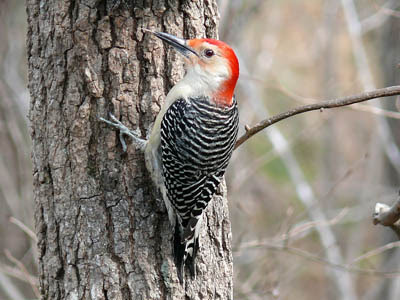 |
| Red-bellied Woodpecker Image by skeeze from Pixabay |
It is found across the eastern United States. It is found throughout Florida.
The common call is a rolling churrr.
Pale gray below, the back is barred completely with black and white. Both sexes have a red nape, on the male it extends all the way over the crown to the bill.
Red-bellied Woodpeckers visit backyard feeders for sunflower seeds, peanuts, and suet. They eat from platform or large hopper feeders and suet cages.
Northern Mockingbird
These birds are common in backyards and brushlands.
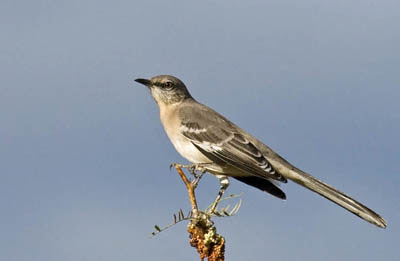 |
| Northern Mockingbird Photo by Greg Gillson |
They are found throughout the southern and eastern United States. They are residents in many areas, migrate in and out of the northern parts of their range. In Florida they are year-round residents.
They are slim and gray with a fairly long pointed bill. They have white wing patches, exposed in flight. They have white outer tail feathers. They sing nearly throughout the year, often at night.
Their song is three notes or phrases repeated, then move on to another set of three. They have a huge repertoire and include mimicking other bird’s calls and mechanical noises.
Northern Mockingbirds may be attracted to your feeder if you offer slices of fruit, including oranges, apples, grapes. They may also eat suet.
Palm Warbler
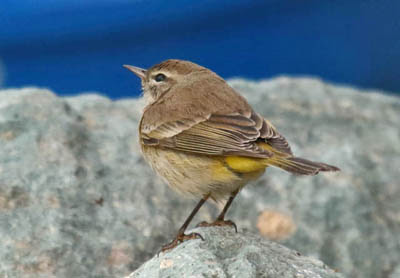 |
| Palm Warbler Photo by Greg Gillson |
These small birds nest in spruce bogs across Canada and extreme northern United States in the East and Midwest. They winter in the Southeast. In Florida they are found throughout in winter.
There they often are found in open brushy areas, lawns, fence lines, and woodland edges, frequently on the ground.
The call is a sharp tsik. The trilled song is only heard in summer.
These birds will visit your suet feeder and may also eat fruit or small seeds.
Gray Catbird
These larger songbirds are secretive inhabitants of thickets.
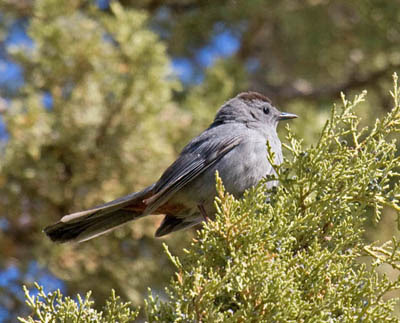 |
| Gray Catbird Photo by Greg Gillson |
In summer they are found across southernmost Canada. In the United States they breed from the Rockies eastward. They are found year round in the southeast coastal states. In Florida they may be year-round residents in the north, but in most of the state they are only found in the winter.
They are dark gray with a black cap. Their under tail coverts are chestnut.
Their voice includes a catlike mewing, but they also mimic other birds.
Catbirds will eat fruit and jelly at your feeder. Try oranges, apples, raisins, and blueberries. They will also eat mealworms and suet.
Yellow-rumped Warbler
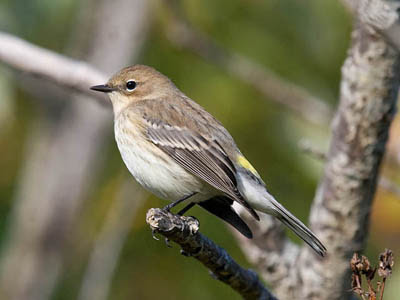 |
| Yellow-rumped Warbler Photo by Greg Gillson |
These abundant warblers nest in conifer and mixed forests across Alaska and Canada and in the mountains of the northeastern United States and the West. They winter along both Atlantic and Pacific coasts of the Unites States and across the southern states into Mexico. They winter throughout Florida.
In summer they are very bright. The upper parts are bluish and they have a black chest. They have a yellow crown patch. Western birds have a yellow throat and large white wing patch. Eastern birds have white throat and two white wing bars.
In winter they are very dull. But, summer or winter, they flash white tail corners in flight and have a bright yellow rump.
They have a complicated slow warble ending in a trill. Their call note is a flat tchep.
While you may see Yellow-rumped Warblers crawling through leafy foliage gleaning insects, or flying out to snatch bugs out of the air, they will come to your feeder if you offer suet.
Setting up a winter bird feeding station in Florida
In Florida, your bird feeder should offer fruits to attract more birds. Birds will eat any kind of single berry, like a blueberry. They will eat apple and orange slices, especially any that may have gone soft on your kitchen counter. Grapes and raisins, too. Grape jelly is a favorite. Feed these in a bowl, perhaps set on a platform feeder or just set out by themselves on a deck railing.
Suet will also attract many birds, including many that don’t eat seeds. Buy no-melt suet in Florida, or make your own following online recipes mixing lard and chunky peanut butter with oats and more. Suet should be fed in suet cages so that other animals don’t take it away.
Mealworms may also be fed in a bowl.
Cardinals like larger seeds. Try safflower or a nut and sunflower seed mixture using a hopper feeder with wide shelf.
Also be sure to have a source of water. Moving water really attracts birds, so a solar fountain might be perfect to add to your feeding station. These need direct sunlight to work, so placement is important.
We didn’t talk about it, but don’t forget a hummingbird feeder. Ruby-throated Hummingbirds are year-round residents in northern Florida, winter visitors in the south. Other rare hummingbirds may show up in winter, too.
Wrapping Up
Winter in Florida is a vibrant time for birdwatching, with plenty of resident and migratory species gracing backyards throughout the state. Here are some winter visitors and residents you might see in your Florida backyard:
Common birds:
- Northern Cardinal: The vibrant red males and tan females of these songbirds are familiar sights at feeders and in backyards.
- American Goldfinch: These bright yellow finches with black wings flock to feeders with sunflower seeds and nyjer seeds.
- Carolina Wren: These energetic, brown wrens with a loud, musical song are often seen hopping around bushes and fences.
- Blue Jay: These noisy, blue and white birds with a distinctive crest are common year-round and love sunflower seeds and peanuts.
- Mockingbird: These talented mimics can serenade your backyard with songs of other birds and their own unique melodies. They like suet and fruit scraps.
Winter migrants:
- Palm Warbler: These yellow warblers with rusty wing patches flit through trees and bushes, wagging their tails. They enjoy sunflower seeds and millet.
- Yellow-bellied Sapsucker: These small woodpeckers with a yellow belly and black chest drum on trees and visit suet feeders.
- Ruby-throated Hummingbird: These tiny jewels might still linger through winter, attracted to hummingbird feeders with diluted sugar water.
- Pine Warbler: These olive-green warblers with two white wing bars frequent open pine woods and evergreen forests. They love sunflower seeds and millet.
- Cedar Waxwing: These elegant, gray birds with red wing tips and yellow bellies flock to trees with berries like juniper and holly.
Frequently Asked Questions
Do birds go to Florida in the winter?
Yes, many birds go to Florida in the winter! In fact, Florida welcomes a fascinating blend of resident and migratory bird species during the colder months, transforming the state into a winter birding paradise. Here’s why:
Milder climate: Compared to northern states with harsh winters, Florida offers a much warmer and more hospitable environment for birds. With milder temperatures, abundant food sources, and diverse habitats, it becomes a haven for both resident and migratory species.
Diverse habitats: Florida boasts a wide range of ecosystems, from coastal beaches and barrier islands to tropical forests, freshwater wetlands, and rolling hills. This variety provides suitable habitats and food sources for a vast array of bird species with different needs.
Food availability: Florida’s abundant plant life provides a constant source of food for birds throughout the winter. Berries, seeds, fruits, and insects thrive in the warmer climate, attracting both insectivores and seed-eaters. Additionally, the state’s extensive coastline and waterways offer ample food for shorebirds and waterfowl.
Types of birds in Florida:
Resident birds: Many beautiful species like Northern Cardinals, Blue Jays, Carolina Wrens, and Mockingbirds reside in Florida year-round, gracing backyards and gardens throughout the winter.
Migratory birds: A large number of bird species migrate south to Florida in winter, including warblers like Palm Warblers and Yellow-bellied Sapsuckers, sparrows like Dark-eyed Juncos and White-throated Sparrows, and even some hummingbirds and raptors.
What do Florida birds do in the winter?
Florida’s winter bird life is a vibrant tapestry of activity, with resident and migratory species engaging in various behaviors depending on their needs and priorities. Here’s a glimpse into what some Florida birds do in the winter:
Resident birds:
Resident species like Northern Cardinals, Blue Jays, and American Robins continue foraging for food throughout the winter. They might visit backyards and feeders for sunflower seeds, suet, fruit scraps, and insects.
Some resident birds, like Carolina Wrens and Mockingbirds, may even start nesting and raising their young during the mild Florida winter.
Many resident birds form flocks in winter, offering warmth and protection from predators. They might be seen foraging together or engaged in social interactions.
Migratory birds:
Like residents, migratory birds focus on replenishing their energy reserves for the journey back north in spring. They might visit feeders, glean berries from native plants, or hunt for insects in warmer habitats.
Many migratory species form large flocks in winter, providing a sense of security and facilitating communication before migration. These flocks might be seen in fields, marshes, or around bodies of water.
Some migratory birds, especially early nesters, might start establishing territories and engaging in courtship behaviors in preparation for spring breeding.
Where do Florida birds go in a hurricane?
The fate of Florida birds during hurricanes depends on a variety of factors, including the species, the stage of the hurricane, and individual behavior. Here’s a breakdown of their possible actions:
Staying put:
Some strong-flying birds, like hawks and owls, may choose to ride out the storm in sheltered locations within the hurricane’s eye or along the calmer sides.
Woodpeckers and parrots might remain hidden inside their sturdy nest cavities, offering some protection from wind and rain.
Ground birds like burrowing owls may seek refuge in their underground burrows, shielded from the worst of the storm’s fury.
Seeking shelter:
Many smaller birds seek shelter in thick bushes, undergrowth, or the lee side of trees to avoid the full force of the wind and rain.
Some birds might find temporary refuge in garages, sheds, or even under houses or bridges.
Caves, rock crevices, and hollow logs can offer safe havens for birds during the storm.
Leaving the area:
Some migratory birds, particularly those in the early stages of migration, might be sensitive to weather changes and leave the area before the hurricane hits.
During the calmer eye of the storm, some strong-flying birds might take advantage of the lull to travel long distances and escape the hurricane’s path.
Strong winds can sometimes blow weaker birds far from their home territory, displacing them and leaving them to find new locations after the storm.
Factors influencing behavior:
Older, experienced birds are better equipped to handle hurricane threats, while younger birds might be more vulnerable and likely to seek shelter or be displaced.
The severity of the hurricane plays a significant role. Birds are more likely to try to ride out weaker storms but may choose to flee for stronger ones.
The presence of suitable shelters and food sources influences where birds can seek refuge and whether they decide to stay or leave.
Related Articles:
The most common backyard birds in Florida
Red, Orange & Yellow Birds in Florida









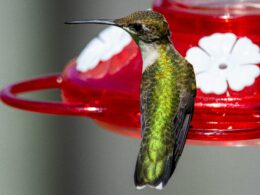
I'm sure others have already noted it, but the caption on the Red-bellied Woodpecker reads "Red-billed Woodpecker"…an even worse name than the authentic one! Great article.
Thanks, France! You were the first one to notice, or at least, the first one to tell me! I appreciate it. I hate typos and misspellings.
I am about to move to SW Fla from northeast of Atlanta GA so good to know what birds to look out for! So excited to have hummingbirds year round!!!
Wonderful. Most hummingbirds are in place for the winter by early December. So it may be hard to attract winter hummingbirds unless your feeder is already up in the summer and fall. Not to worry, though, you'll soon have them buzzing around. The first spring migrants arrive in March.